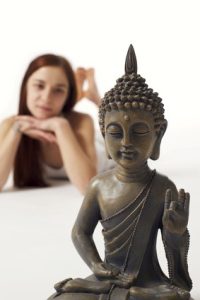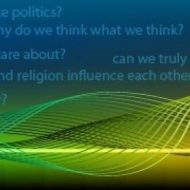By Connor Wood
 In Europe and North America, most religious people are Christian. This means that debates between theological liberals and conservatives in these countries are often about things like the divinity of Christ, the validity of other world religions, and the existence of Hell. But the Spectrums project team has been researching patterns in ideology that transcend just the Christian tradition, and contemporary Buddhism offers a powerful example of how conservative/liberal differences play out in non-Christian faiths. A series of innovative websites on Buddhist culture and secularism demonstrates exactly how.
In Europe and North America, most religious people are Christian. This means that debates between theological liberals and conservatives in these countries are often about things like the divinity of Christ, the validity of other world religions, and the existence of Hell. But the Spectrums project team has been researching patterns in ideology that transcend just the Christian tradition, and contemporary Buddhism offers a powerful example of how conservative/liberal differences play out in non-Christian faiths. A series of innovative websites on Buddhist culture and secularism demonstrates exactly how.
Some important patterns repeat themselves in the relationship between religious liberalism and conservatism. For example, conservatives tend to be much more interested in maintaining stable communities over time, while liberals are more open to shifting, fluid boundaries in their religious communities. Conservatives value authority and tradition, while liberals believe that individuals ought to decide how to do things on their own. Religious conservatives are typically more comfortable with absolute truth claims, such as that there is such a thing as absolute right and wrong. Liberals, on the other hand, often hesitate to make such claims, since they are well aware that many different cultures have differing beliefs, and that what is right in one society may be wrong in another.
An image might help: imagine an enormous room filled with giant balls of different sizes and colors. These balls are big enough for people to live in them; in fact, some people live out their entire lives inside of them. If each ball is a religion, the people who live closer to the center are the conservatives of that tradition, cocooned far away from the shifting boundaries with other faiths. Any news about what life is like in the other balls has to travel a long way before it reaches the ears of the conservatives, and by the time it does it often seems strange and dreamlike, like news from an imaginary world.
Liberals, in contrast, are the people who live at the edges of each ball: they’re constantly bumping and rubbing up against other religious worldviews, and so the warm center of their own sphere seems very far away indeed. They sometimes even find they have more in common with the inhabitants of the edges of other balls than they do with the conservatives living at the core of their own.
In this sense, the Buddhist sphere isn’t any different from the Christian one. Near the core, conservative Buddhists are enveloped in a totalizing, longstanding worldview that seems to have been around forever. Depending on their type of Buddhism, this worldview might include the existence of boddhisattvas, endless reincarnations, or the divine status of the Buddha himself. Things don’t change very quickly at the center, and for its inhabitants other religions like Christianity or Islam seem impenetrably strange – almost unreal.
So if that’s the center, what does the Buddhist ball look like at its edges?
A relatively new collection of websites, anchored by one site appropriately named The Secular Buddhist, has the answer to that question. The (mostly American and Canadian) thinkers who maintain and write on these websites are generally well-educated Western practitioners of Buddhist meditation, and they don’t believe in boddhisattvas, literal reincarnation, or divine anythings. Instead, Buddhism for them is a type of mental practice and a philosophy about how to engage comfortably, even healthily, with the world and with their own minds. Perhaps unsurprisingly, these writers tend to elevate science to a place of high esteem, preferring its promise of objectivity over the seeming unreliability of religious beliefs. In short, they are residents of the very perimeter of the Buddhist religious sphere, breathing the rarified air of cross-cultural perspective, unimpressed by tradition or venerable authority, and highly aware of the existence of many, often competing, religious worldviews.
The Secular Buddhist offers a series of fine examples of this perspective, such as the assertion that “(s)ecular Buddhism values individual preference and creativity (in) the forms of practice” that individual participants choose. In a very real sense, this is religious liberalism in its purest form: secular Buddhists are interested in engaging a tradition and taking from it what they find useful, but they refuse to take the whole apple in one bite. They reject claims about literal reincarnation, for example, preferring instead to substitute naturalistic perspectives. (Compare this to liberal Christianity in the US, where many mainline Protestants deny the literal resurrection and divinity of Christ, holding up Jesus instead as an allegorical example of ideal human behavior.)
Other blogs and websites build on the liberal foundations of the Secular Buddhist, including the Natural Buddhist, which offers an exemplary description of reincarnation from a secular, naturalistic perspective. There’s also Progressive Buddhism, which argues that modern Buddhists are too tribal and not concerned enough with the suffering of people in non-Buddhist parts of the world. The writers of Progressive Buddhism even exhort their readers not to “get bogged down in Buddhism.” Meanwhile, a blog called Speculative Non-Buddhism advocates the use of Buddhist practice without all the cultural baggage of traditional Asian norms and beliefs.
So how is this religious liberalism rather than just secularism? Well, some people would argue there’s not much difference. But it’s clear that the writers of these websites and blogs care passionately about Buddhism and what its practices have offered the world – they’re part of a millennia-old conversation on the Buddha’s teachings and what those teachings mean. This means that, whether they like it or not, they’re within the boundaries of the Buddhist world (even if they might be closer to the edges than most). In this sense, they’re religious liberals: people who are somehow engaged with a religious tradition, but who sit further away from the center – sometimes much further – than the steadfast, loyal conservatives.
Much more could be written on what secular or progressive Buddhism can tell us about religious liberalism, but one important point remains: while progressive Buddhists share many values with contemporary global culture, religious liberalism isn’t always perfect. Conservatives often have stronger communities, since the beliefs and worldviews they share are more resilient and intact. With more cohesive theological perspectives, conservative traditions can also be better-equipped to help adherents deal with life’s inevitable disappointments, like sickness, suffering, and death. Liberal religion, then, often answers some important questions – like how to reconcile religious beliefs with objective science, a particularly important point for many liberal Buddhists – in ways that raise other questions in their place.
In short, neither liberal nor conservative Buddhism is necessarily perfect. But writers on websites like the Secular Buddhist are demonstrating an attempt to do something very important: reconcile ancient religious beliefs with modern knowledge and society. By dismissing divine beings or literal reincarnation, they distance themselves from the traditional center of most Buddhist religion – but that’s what liberal religion is all about. It’s wild out on the edge, but somebody’s gotta be there.
For further insight into the conservative/liberal divide in modern American Buddhism, click to read an exchange between noted Buddhist scholar B. Allan Wallace and the author of the Secular Buddhist.
